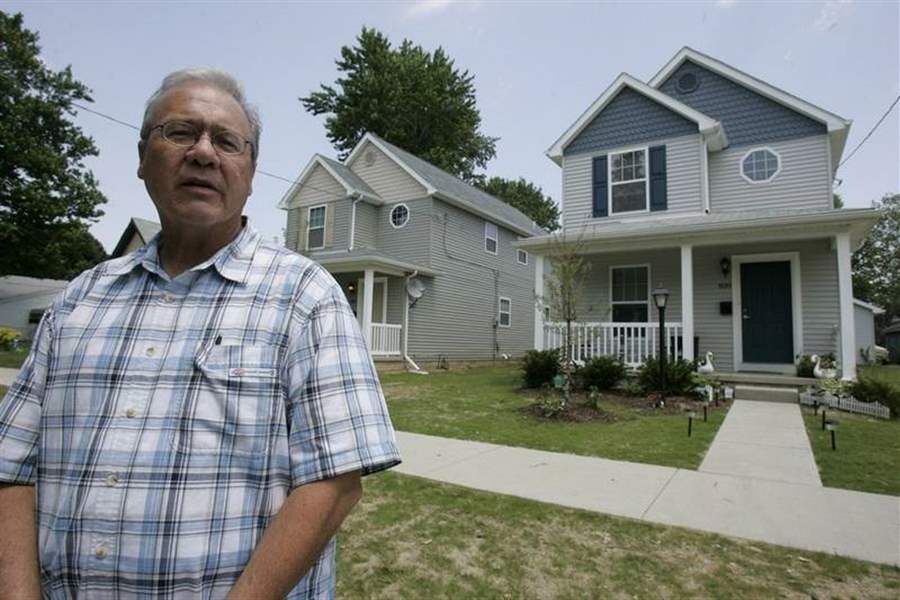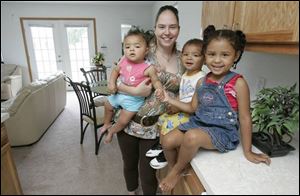
Program fosters home ownership for needy families
6/17/2007
Bill Farnsel, executive director of Neighborhood Housing Services, plans to build 25 more houses in the fall. He says the program offers attractive terms but it is not a rent-to-own deal.

Aimee Przybysz and children Jayla Shuman, 1, left, Jamall Shuman, 2, and Jazmine Shuman, 4, in a new four-bedroom home.
Aimee Przybysz lives in something she never thought she would be living in - a brand-new home.
Her house is 1,400 square feet, with four bedrooms. It has two bathrooms, a full basement, a garage, and French doors opening on to a backyard. Its furnace and air conditioning are high-efficiency.
"I love it," the 23-year-old single mother of three said. "It means the world to me."
Her place is on the 800 block of Yondota Street in East Toledo, a low-income neighborhood and an unlikely venue for new-home construction.
But new houses are springing up in some older Toledo neighborhoods on the east side and near south end, thanks to the efforts of a local nonprofit development group and a lot of assistance at the federal and local levels.

Bill Farnsel, executive director of Neighborhood Housing Services, plans to build 25 more houses in the fall. He says the program offers attractive terms but it is not a rent-to-own deal.
Neighborhood Housing Services, the development group, has recently built 28 homes like Ms. Przybysz's on such streets as Walbridge, Marion, Crittenden, South, Yondota, Utah, Viking, and Oak. The cost: $4.2 million.
A visitor to those streets cannot but notice the new construction standing in obvious contrast to the other homes, which are aging and often run-down.
Lots for the homes were purchased from Toledo's land bank of foreclosed properties for $145 each. For the first 15 years, the homes are taxed only on the value of their lot.
The new homes were built using the federal Low Income Housing Tax Credit, which provides federal tax credits for investments in low-income housing and attracts investors who might otherwise not give these neighborhoods a look.
This tax credit has been used to build house in other parts of Toledo, noted Bill Farnsel, executive director of Neighborhood Housing Services, but not in these neighborhoods with the same huge incentive offered to renters.
If tenants such as Ms. Przybysz pay their rent and take care of their property, they can buy their home for a knocked-down price after 15 years.
Ms. Przybysz's house cost $189,000 to build, of which land and construction accounted for $140,000. The rest went to administrative and other costs.
Ms. Przybysz pays $520 in monthly rent. If she exercised her right of first refusal after 15 years, Mr. Farnsel estimated her purchase price would be $40,000 to $50,000.
Moreover, Mr. Farnsel's agency would be able to lend her the money on advantageous terms.
Mr. Farnsel emphasized that this is not a rent-to-buy program. The renter does not accrue equity in the property.
Still, "It's a deal you won't get anywhere else. The basic proposition is, if you rent for 15 years, you can cash in," Mr. Farnsel said.
None of this is lost on Ms. Przybysz, an unemployed nurse's aide who hopes to have work soon. She has lived in her house only two months but already dreams of owning it.
"I would like to buy," she said. "I'm thankful for the program. It gives single mothers a chance."
Rents are charged on a sliding scale based on household size and income. An eligible family of four could have income no greater than $35,350, which is 60 percent of the area's median. For a household of one, the maximum income would be $24,750.
The below-market prices are made possible by a substantial federal tax credit, which amounts to about $470,000 per year for the 28 homes for 10 years and is the draw for equity investors, Mr. Farnsel said.
The main equity investor is Local Initiatives Support Corp., a nationwide nonprofit whose subsidiary, National Equity Fund, acts as a syndicator of tax credits for low-income housing.
Investors tend to be big corporations such as insurance companies and banks with large federal tax liabilities, explained Hugh Grefe, LISC's senior program director in Toledo.
Congress created the Low Income Housing Tax Credit with the Tax Reform Act of 1986. Its aim was to shift from direct federal spending on public housing by providing incentives for private development, Mr. Grefe said.
"This is an investment activity. It's not philanthropy per se," he added.
KeyBank was heavily involved in the project as the lender of construction funds.
The bank's financing was an arm's-length commercial loan, said Teresa Smith, KeyBank's vice president of community development banking.
"What we're providing is a quality product for the working poor of the city," Ms. Smith said. "Most of the renters here don't know anyone who lives in a new house and don't have that tradition in their family. This mechanism is really a way to get them into that. You can't buy a new house if you're making $10 an hour."
KeyBank's involvement in projects such as this also demonstrated to regulators that the lender was serving neighborhoods of all socioeconomic levels, Ms. Smith explained.
Mr. Farnsel, for his part, plans to build another 25 homes and offer them to low-income renters in the same way. He expects construction to begin in the fall. "Our mission is to turn people into homeowners after 15 years," he said.
Contact Carl Ryan at:
carlryan@theblade.com